Molecular Dynamics Simulation of the Interaction between Common Metal Ions and Humic Acids
Abstract
1. Introduction
2. Models and Computational Methods
3. Results and Discussion
3.1. System Equilibrium and Interaction Energy
3.2. RDFs and Coordination Number
3.3. Solvent Accessible Surface Areas and Hydrogen Bonds
4. Conclusions
Author Contributions
Funding
Acknowledgments
Conflicts of Interest
References
- Kalinichev, A.G.; Iskrenova-Tchoukova, E.; Ahn, W.Y.; Clark, M.M.; Kirkpatrick, R.J. Effects of Ca2+ on supramolecular aggregation of natural organic matter in aqueous solutions: A comparison of molecular modeling approaches. Geoderma 2011, 169, 27–32. [Google Scholar] [CrossRef]
- Stedmon, C.A.; Thomas, D.N.; Granskog, M.; Kaartokallio, H.; Papadimitriou, S.; Kuosa, H. Characteristics of dissolved organic matter in Baltic coastal sea ice: Allochthonous or autochthonous origins? Environ. Sci. Technol. 2007, 41, 7273–7279. [Google Scholar] [CrossRef] [PubMed]
- Leenheer, J.A. Systematic approaches to comprehensive analyses of natural organic matter. Ann. Environ. Sci. 2009, 3, 1–130. [Google Scholar]
- Hong, S.; Elimelech, M. Chemical and physical aspects of natural organic matter (NOM) fouling of nanofiltration membranes. J. Membr. Sci. 1997, 132, 159–181. [Google Scholar] [CrossRef]
- Ahn, W.Y.; Kalinichev, A.G.; Clark, M.M. Effects of background cations on the fouling of polyethersulfone membranes by natural organic matter: Experimental and molecular modeling study. J. Membr. Sci. 2008, 309, 128–140. [Google Scholar] [CrossRef]
- Liu, S.S.; Zhu, Y.R.; Liu, L.Z.; He, Z.; Giesy, J.P.; Bai, Y.; Sun, F.; Wu, F. Cation-induced coagulation of aquatic plant-derived dissolved organic matter: Investigation by EEM-PARAFAC and FT-IR spectroscopy. Environ. Pollut. 2018, 234, 726–734. [Google Scholar] [CrossRef]
- Stolpe, B.; Guo, L.D.; Shiller, A.M.; Aiken, G.R. Abundance, size distributions and trace-element binding of organic and iron-rich nanocolloids in Alaskan rivers, as revealed by field-flow fractionation and ICP-MS. Geochim. ET Cosmochim. Acta 2013, 105, 221–239. [Google Scholar] [CrossRef]
- Yan, M.Q.; Wang, D.S.; Korshin, G.V.; Benedetti, M.F. Quantifying metal ions binding onto dissolved organic matter using log-transformed absorbance spectra. Water Res. 2013, 47, 2603–2611. [Google Scholar] [CrossRef]
- Yamashita, Y.; Jaffé, R. Characterizing the interactions between trace metals and dissolved organic matter using excitation-emission matrix and parallel factor analysis. Environ. Sci. Technol. 2008, 42, 7374–7379. [Google Scholar] [CrossRef]
- Kikuchi, T.; Fujii, M.; Terao, K.; Jiwei, R.; Lee, Y.P.; Yoshimura, C. Correlations between aromaticity of dissolved organic matter and trace metal concentrations in natural and effluent waters: A case study in the Sagami River Basin, Japan. Sci. Total Environ. 2017, 576, 36–45. [Google Scholar] [CrossRef]
- Xu, H.C.; Guan, D.X.; Zou, L.; Lin, H.; Guo, L. Contrasting effects of photochemical and microbial degradation on Cu(II) binding with fluorescent DOM from different origins. Environ. Pollut. 2018, 239, 205–214. [Google Scholar] [CrossRef] [PubMed]
- Wu, Z.H.; Gu, Z.M.; Wang, X.R.; Evans, L.; Guo, H. Effects of organic acids on adsorption of lead onto montmorillonite, goethite and humic acid. Environ. Pollut. 2003, 121, 469–475. [Google Scholar] [CrossRef]
- Tan, L.Q.; Yu, Z.W.; Tan, X.L.; Fang, M.; Wang, X.; Wang, J.; Xing, J.; Ai, Y.; Wang, X. Systematic studies on the binding of metal ions in aggregates of humic acid: Aggregation kinetics, spectroscopic analyses and MD simulations. Environ. Pollut. 2019, 246, 999–1007. [Google Scholar] [CrossRef] [PubMed]
- Stirpe, A.; Rizzuti, B.; Pantusa, M.; Bartucci, R.; Sportelli, L.; Guzzi, R. Thermally induced denaturation and aggregation of BLG-A: Effect of the Cu2+ and Zn2+ metal ions. Eur. Biophys. J. Biophys. Lett. 2008, 37, 1351–1360. [Google Scholar] [CrossRef]
- Kalinichev, A.G.; Kirkpatrick, R.J. Molecular dynamics simulation of cationic complexation with natural organic matter. Eur. J. Soil Sci. 2007, 58, 909–917. [Google Scholar] [CrossRef]
- Ai, Y.J.; Zhao, C.F.; Sun, L.; Wang, X.; Liang, L. Coagulation mechanisms of humic acid in metal ions solution under different pH conditions: A molecular dynamics simulation. Sci. Total Environ. 2020, 702. [Google Scholar] [CrossRef]
- Oren, Y.; Korngold, E.; Daltrophe, N.; Messalem, R.; Volkman, Y.; Aronov, L.; Weismann, M.; Bouriakov, N.; Glueckstern, P.; Gilron, J. Pilot studies on high recovery BWRO-EDR for near zero liquid discharge approach. Desalination 2010, 261, 321–330. [Google Scholar] [CrossRef]
- Davies, G.; Fataftah, A.; Cherkasskiy, A.; Ghabbour, E.A.; Radwan, A.; Jansen, S.A.; Kolla, S.; Paciolla, M.D.; Sein, L.T.; Fataftah, A.; et al. Tight metal binding by humic acids and its role in biomineralization. J. Chem. Soc. Dalton Trans. 1997, 1997, 4047–4060. [Google Scholar] [CrossRef]
- Sutton, R.; Sposito, G. Molecular structure in soil humic substances: The new view. Environ. Sci. Technol. 2005, 39, 9009–9015. [Google Scholar] [CrossRef]
- Xu, X.; Kalinichev, A.G.; Kirkpatrick, R.J. 133Cs and 35Cl NMR spectroscopy and molecular dynamics modeling of Cs+ and Cl− complexation with natural organic matter. Geochim. Cosmochim. Acta 2006, 70, 4319–4331. [Google Scholar] [CrossRef]
- Jansena, S.A.; Malaty, M.; Nwabara, S.; Johnson, E.; Ghabbour, E.; Davies, G.; Varnum, J.M. Structural modeling in humic acids. Mater. Sci. Eng. C 1996, 4, 175–179. [Google Scholar] [CrossRef]
- Sein, L.T.; Varnum, J.M.; Jansen, S.A. Conformational Modeling of a New Building Block of Humic Acid: Approaches to the Lowest Energy Conformer. Environ. Sci. Technol. 1999, 33, 546–552. [Google Scholar] [CrossRef]
- Piccolo, A. The supramolecular structure of humic substances: A novel understanding of humus chemistry and implications in soil science. Adv. Agron. 2002, 75, 57–134. [Google Scholar]
- Steelink, C. Implications of elemental characteristics of humic substances. In Humic Substances in Soil, Sediment, and Water; Aiken, G.R., McKnight, D.M., Warshaw, R.L., Eds.; Wiley: New York, NY, USA, 1985; pp. 457–476. [Google Scholar]
- Diallo, M.S.; Simpson, A.; Gassman, P.; Faulon, J.L.; Johnson, J.H.; Goddard, W.A.; Hatcher, P.G. 3-D structural modeling of humic acids through experimental characterization, computer assisted structure elucidation and atomistic simulations. 1. Chelsea soil humic acid. Environ. Sci. Technol. 2003, 37, 1783–1793. [Google Scholar] [CrossRef] [PubMed]
- Sutton, R.; Sposito, G.; Diallo, M.S.; Schulten, H.-R. Molecular simulation of a model of dissolved organic matter. Environ. Toxicol. Chem. 2005, 24, 1902–1911. [Google Scholar] [CrossRef] [PubMed]
- Ritchie, J.D.; Perdue, E.M. Proton-binding study of standard and reference fulvic acids, humic acids, and natural organic matter. Geochim. Cosmochim. Acta 2003, 67, 85–96. [Google Scholar] [CrossRef]
- Sun, H.J. COMPASS: An ab Initio Force-Field Optimized for Condensed-Phase Applications Overview with Details on Alkane and Benzene Compounds. J. Phys. Chem. B 1998, 102, 7338–7364. [Google Scholar] [CrossRef]
- Kubicki, J.D. Molecular mechanics and quantum mechanical modeling of hexane soot structure and interactions with pyrene. Geochem. Trans. 2000, 1, 41–46. [Google Scholar] [CrossRef]
- Tsierkezos, N.G.; Molinou, I.E. Thermodynamic Properties of Water + Ethylene Glycol at 283.15, 293.15, 303.15, and 313.15 K. J. Chem. Eng. Data 1998, 43, 989–993. [Google Scholar] [CrossRef]
- Yuan, S.L.; Ma, L.X.; Zhang, X.Q.; Zheng, L. Molecular dynamics studies on monolayer of cetyltrimethylammonium bromide surfactant formed at the air/water interface. Colloids Surf. A Physicochem. Eng. Asp. 2006, 289, 1–9. [Google Scholar] [CrossRef]
- Zhao, T.T.; Xu, G.Y.; Yuan, S.; Chen, Y.; Yan, H. Molecular dynamics study of alkyl benzene sulfonate at air/water interface: Effect of inorganic salts. J. Phys. Chem. B 2010, 114, 5025–5033. [Google Scholar] [CrossRef] [PubMed]
- Chen, Y.J.; Xu, G.Y.; Yuan, S.L.; Sun, H.-Y. Molecular dynamics simulations of AOT at isooctane/water interface. Colloids Surf. A Physicochem. Eng. Asp. 2006, 273, 174–178. [Google Scholar] [CrossRef]
- Xu, J.F.; Zhang, Y.; Chen, H.X.; Wang, P.; Xie, Z.; Yao, Y.; Yan, Y.; Zhang, J. Effect of surfactant headgroups on the oil/water interface: An interfacial tension measurement and simulation study. J. Mol. Struct. 2013, 1052, 50–56. [Google Scholar] [CrossRef]
- Gao, S.M.; Kang, Z.H.; Yuan, R.X.; Liu, N.; Zhu, P.; Wang, B. Molecular dynamics study of nonylphenol-substituted dodecyl sulfonate at air/water interface: Role of steric effect of surfactant headgroups. J. Mol. Struct. 2019, 1192, 35–41. [Google Scholar] [CrossRef]
- Iskrenova-Tchoukova, E.; Kalinichev, A.G.; Kirkpatrick, R.J. Metal Cation Complexation with Natural Organic Matter in Aqueous Solutions: Molecular Dynamics Simulations and Potentials of Mean Force. Langmuir 2010, 26, 15909–15919. [Google Scholar] [CrossRef]

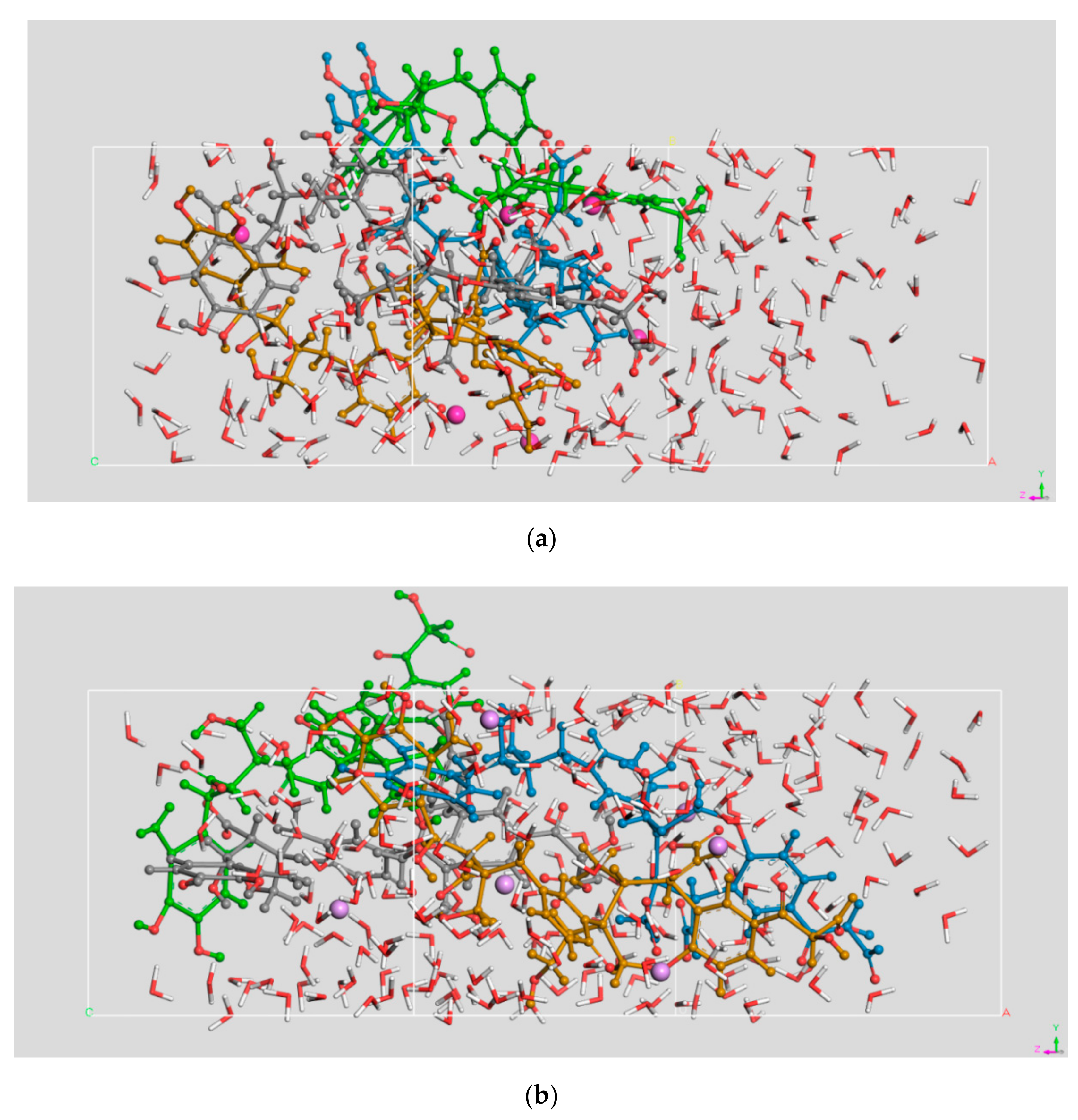
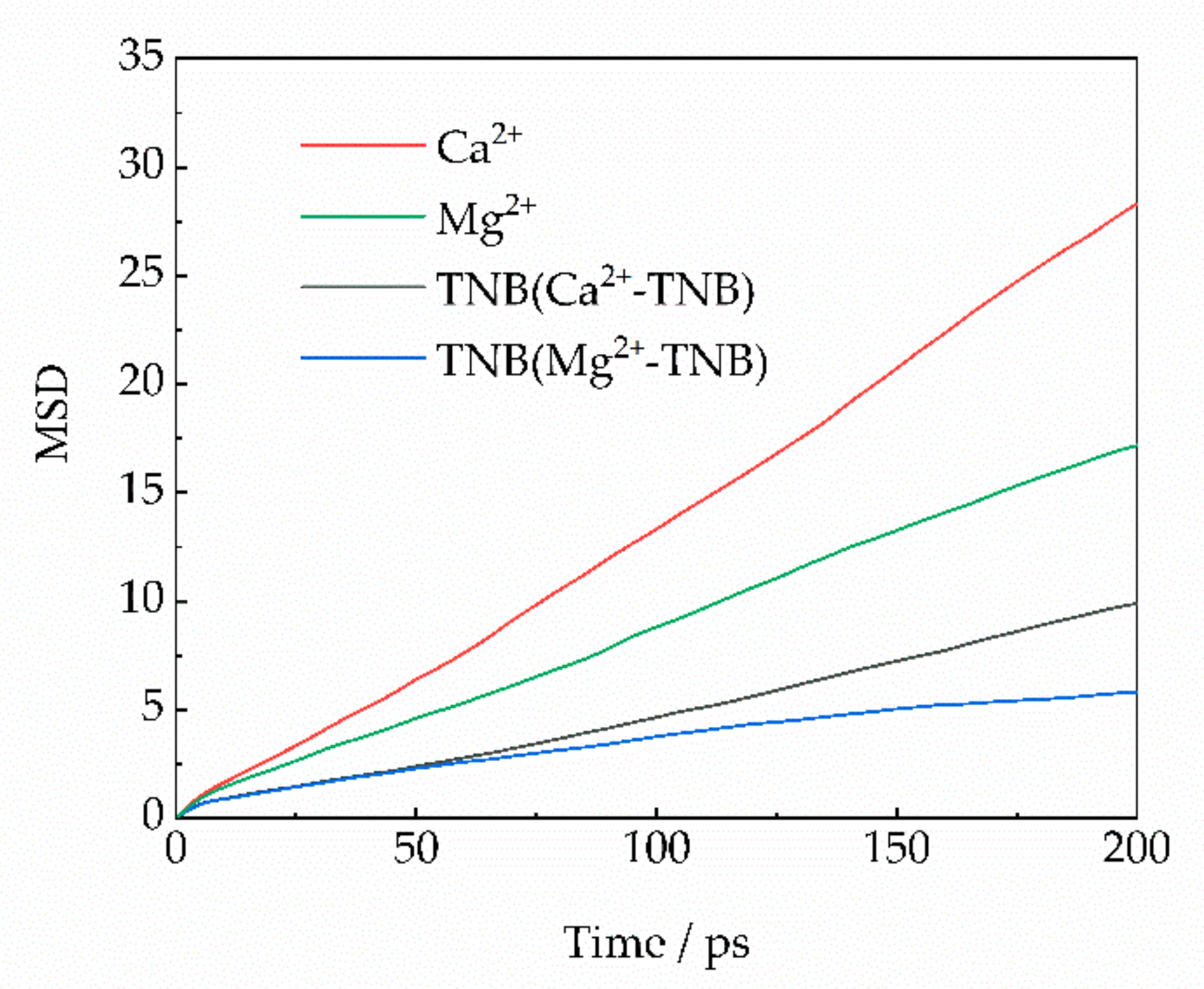
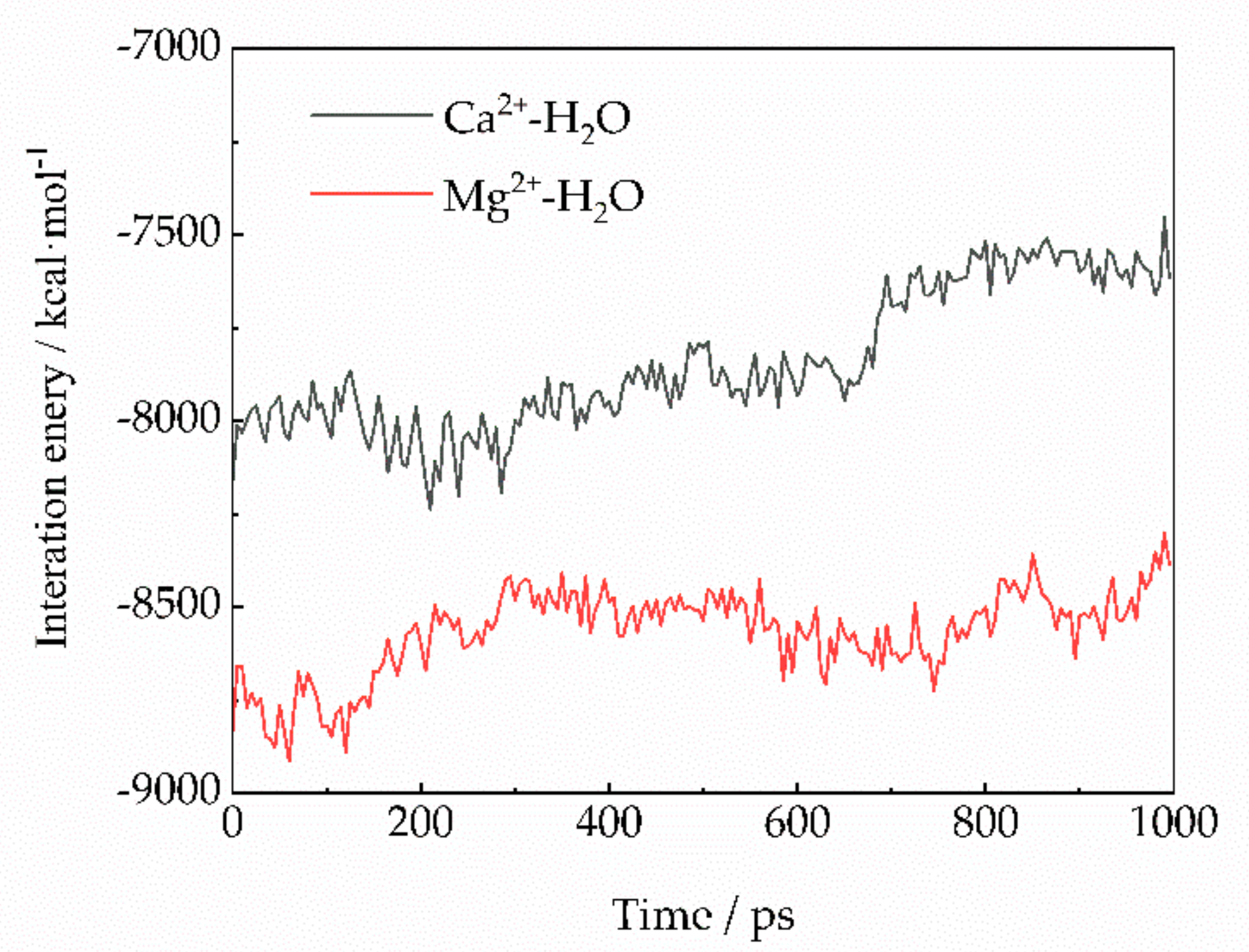
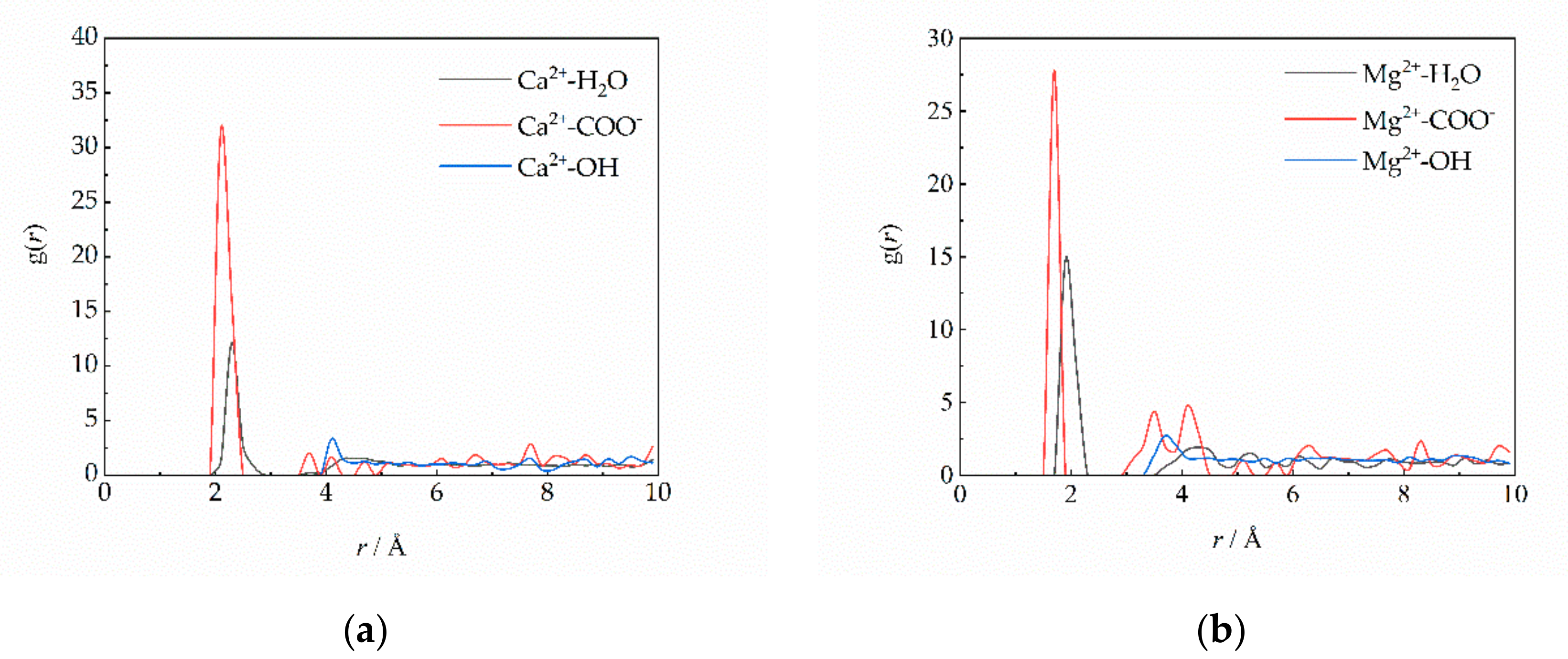
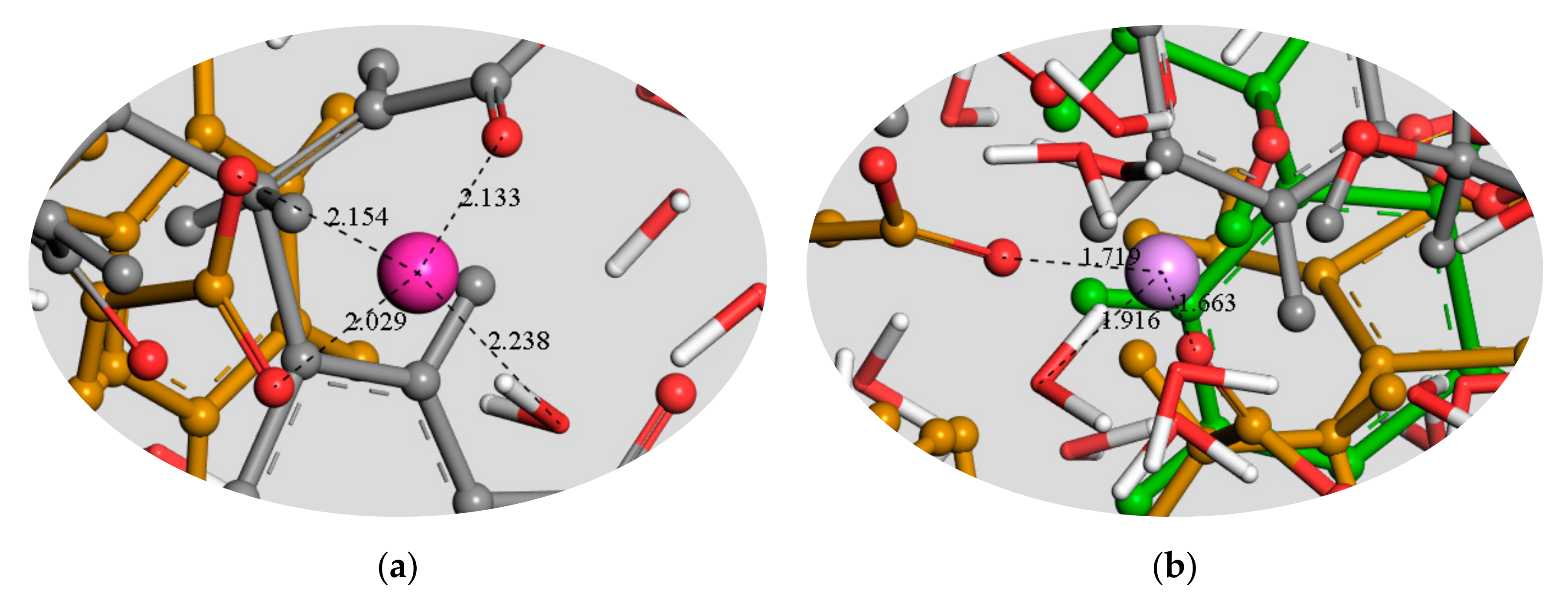
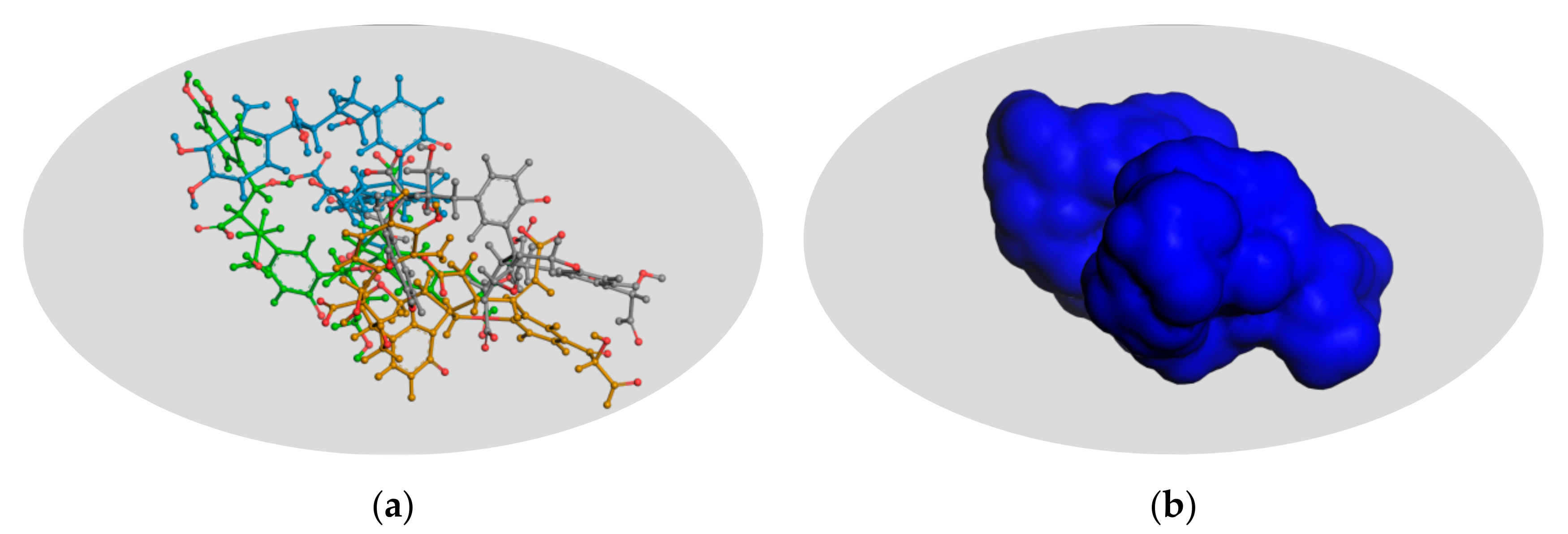
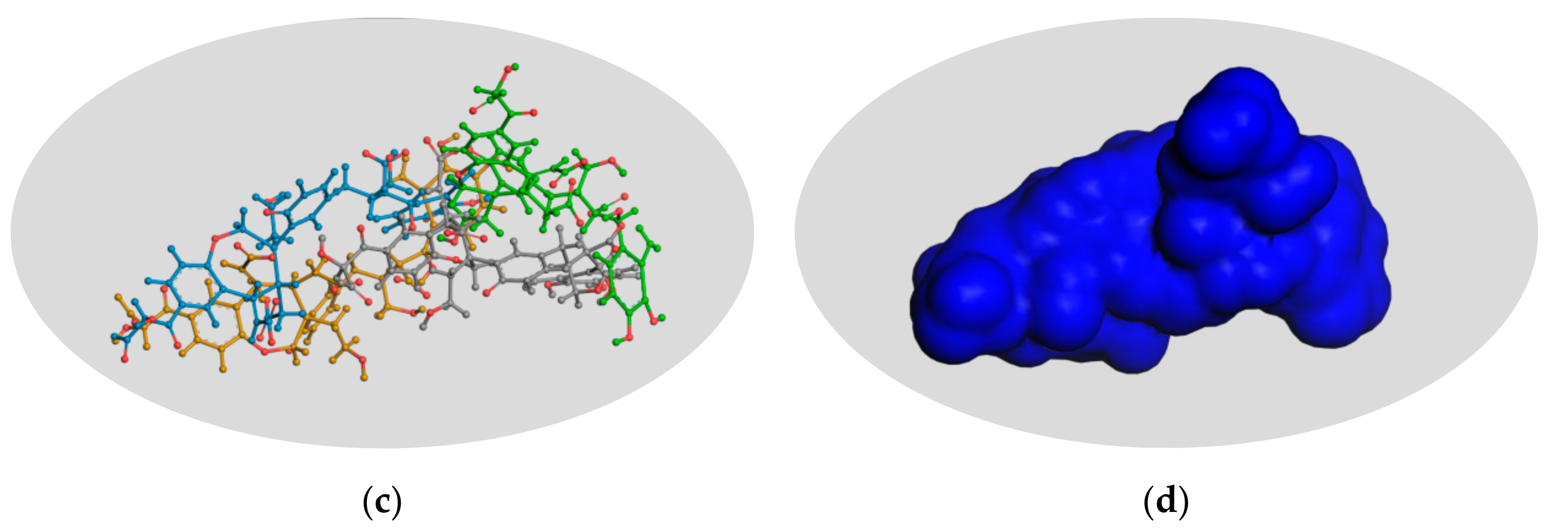
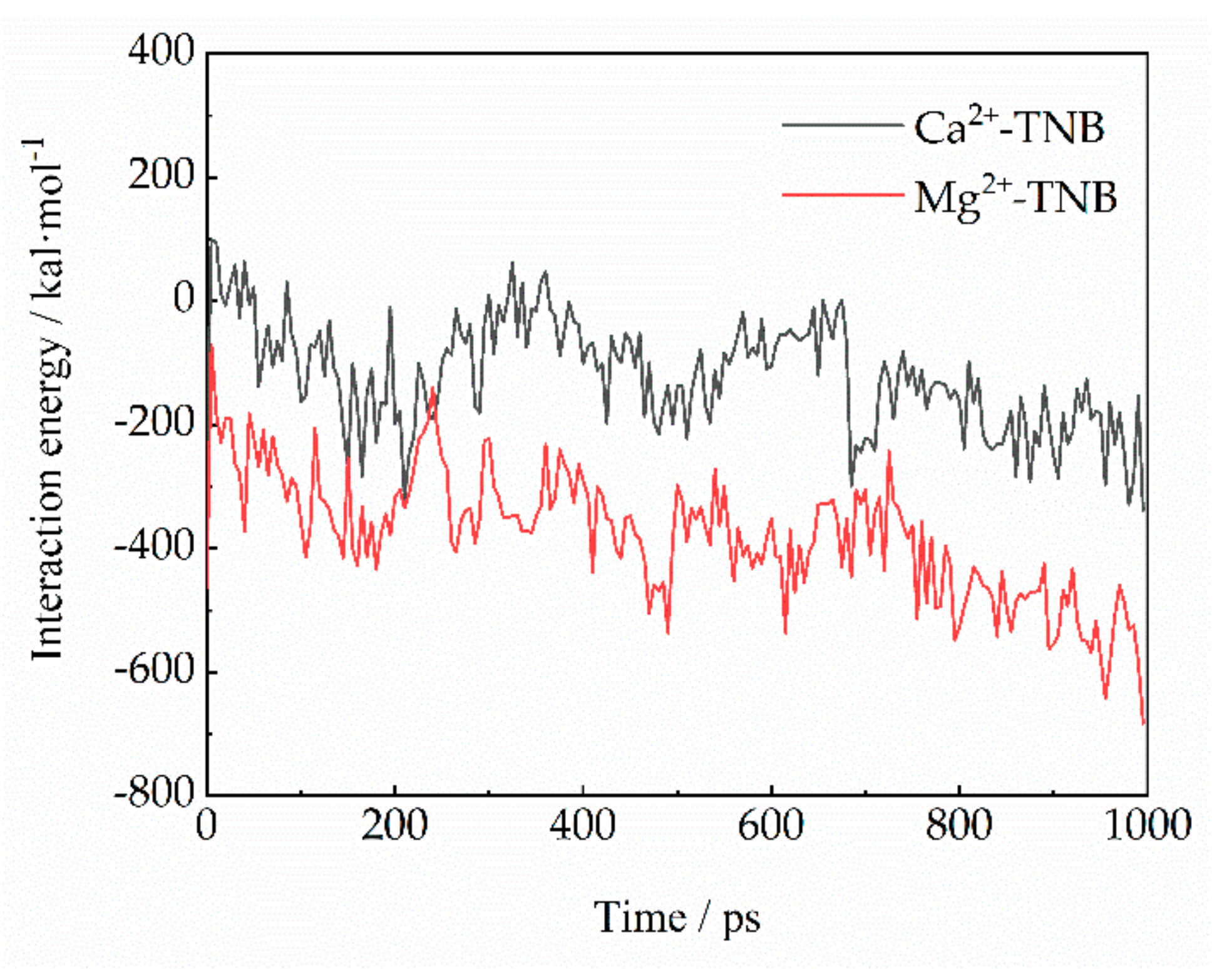
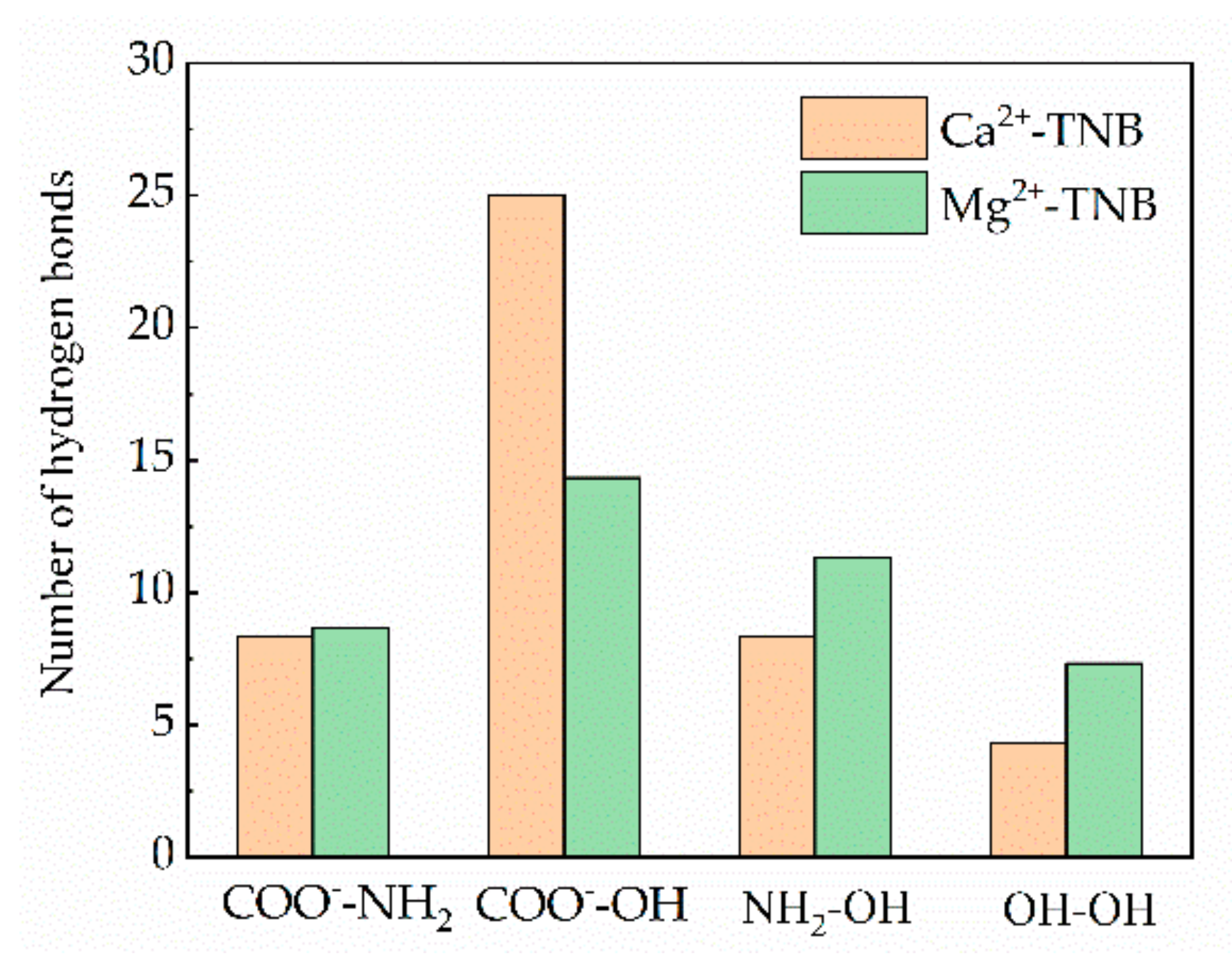
| C (wt.%) | H (wt.%) | O (wt.%) | N (wt.%) | S (wt.%) | P (wt.%) | Reference | |
|---|---|---|---|---|---|---|---|
| TNB | 57.4 | 4.9 | 34.0 | 3.7 | - | - | [18] |
| Steelink | 59.5 | 5.2 | 33.5 | 1.8 | - | - | [24] |
| CSHA#9 | 53.3 | 4.2 | 37.9 | 1.4 | 3.0 | - | [25] |
| Schulten | 51.5 | 4.0 | 41.8 | 2.0 | 0.6 | - | [26] |
| Exp. (SRHA) | 52.5 | 4.2 | 42.7 | 1.1 | 0.6 | 0.02 | [27] |
| Ca2+ | Mg2+ | TNB (Ca2+-TNB) | TNB (Mg2+-TNB) | |
|---|---|---|---|---|
| D/10−9 m2 s−1 | 1.179 | 0.709 | 0.399 | 0.230 |
| R2 | 0.998 | 0.999 | 0.996 | 0.983 |
| System | Hydrophilic Group | Peak1/Å | Peak2/Å | n1 | n2 | Total |
|---|---|---|---|---|---|---|
| Ca2+-TNB | COO− | 2.1 | 3.7 | 1.59 | 0.10 | 1.69 |
| OH | 4.1 | / | 0.27 | / | 0.27 | |
| H2O | 2.3 | 4.5 | 0.57 | 0.30 | 0.87 | |
| Mg2+-TNB | COO− | 1.7 | 3.5 | 0.92 | 0.31 | 1.23 |
| OH | 3.7 | / | 0.25 | / | 0.25 | |
| H2O | 1.9 | 4.3 | 0.74 | 0.27 | 1.01 |
Publisher’s Note: MDPI stays neutral with regard to jurisdictional claims in published maps and institutional affiliations. |
© 2020 by the authors. Licensee MDPI, Basel, Switzerland. This article is an open access article distributed under the terms and conditions of the Creative Commons Attribution (CC BY) license (http://creativecommons.org/licenses/by/4.0/).
Share and Cite
Wu, X.; Xia, Y.; Yuan, L.; Xia, K.; Jiang, Y.; Li, N.; He, X. Molecular Dynamics Simulation of the Interaction between Common Metal Ions and Humic Acids. Water 2020, 12, 3200. https://doi.org/10.3390/w12113200
Wu X, Xia Y, Yuan L, Xia K, Jiang Y, Li N, He X. Molecular Dynamics Simulation of the Interaction between Common Metal Ions and Humic Acids. Water. 2020; 12(11):3200. https://doi.org/10.3390/w12113200
Chicago/Turabian StyleWu, Xu, Yu Xia, Lianhua Yuan, Kaiyu Xia, Yu Jiang, Na Li, and Xuwen He. 2020. "Molecular Dynamics Simulation of the Interaction between Common Metal Ions and Humic Acids" Water 12, no. 11: 3200. https://doi.org/10.3390/w12113200
APA StyleWu, X., Xia, Y., Yuan, L., Xia, K., Jiang, Y., Li, N., & He, X. (2020). Molecular Dynamics Simulation of the Interaction between Common Metal Ions and Humic Acids. Water, 12(11), 3200. https://doi.org/10.3390/w12113200




